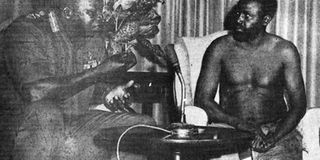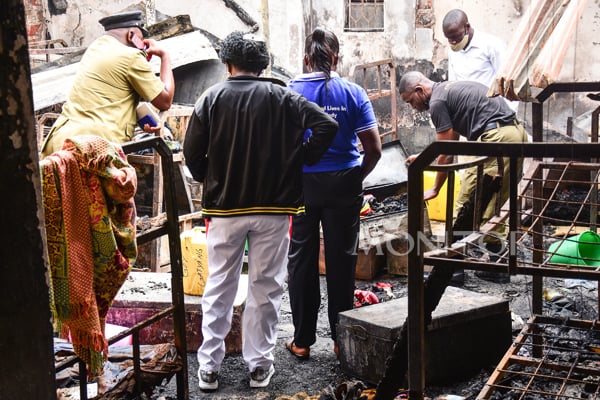Prominent people killed during Amin’s 8-year rule

Former minister for Information in the UPC government Alex Ojera (R) meets president Idi Amin in Kampala following his arrest in September 1972. PHOTOS | FILE
What you need to know:
- Exactly 42 years ago today, president Idi Amin’s military government was overthrown following a six-month war between Uganda and combined forces of Tanzanian army and Ugandan guerrillas. However, Amin’s eight-year rule was no ordinary one. Stories of killings and disappearances during his rule have been told over the years. Felix Ocen revisits some of the most prominent cases.
Amid an endless wave of killings by Idi Amin’s henchmen following the 1971 military takeover, according to the book To Those Who Have Died, Milton Obote’s army chief of staff, Brig Hassan Suleiman, whose appointment Amin had bitterly opposed only three months before the coup, was captured in Kampala as he tried to flee the country.
Taken to Luzira Maximum Security Prison, Suleiman died slowly after being beaten with rifle butts and slashed with pangas.
In Kampala, Maj Emannuel Ogwal, a pro-Obote suspect, was intercepted around the presidential lodge in Nakasero.
As Amin’s officers chased Ogwal through the city centre, he took refuge in a doctor’s house from where he was captured. The unsuspecting owner of the house, Dr George Ebine, a British-trained gynaecologist, was traced to Mulago hospital, dragged from the operating theatre along with the patient he had been treating and taken to Malire Regiment, Lubiri.
Ogwal, together with Prof Vincent Emiru, an eye specialist who had been seized from his office at Makerere University, was crushed with a tank.
Directive
Around the same time, Amin issued a directive to all members of the General Service Unit (Obote’s special forces), giving them 24 hours to turn themselves in. Those who obeyed the order were captured, beaten and jailed at Lira Barracks.
After weeks of detention, they were herded together at gunpoint and jostled aboard the trucks. Near the Karuma Falls, they were bayonetted and shot and their bodies thrown into the falls.
The picture of what was happening inside Uganda’s prisons was first given by Obote’s former minister of Public Service and Cabinet Affairs, Joshua Wakholi to British journalist David Martins.
Wakholi had been arrested in March 1971 and detained at Makindye. He was placed next door to a notorious cell called “Singapore” (named after the city where Obote was during the 1971 coup).
In another incidence, following the killings of Acholi and Langi soldiers in Mbarara, Jinja and other garrison towns in July 1971, two Americans, Nicholas Stroh, a correspondent of the Evening Bulletin, Philadelphia, and Robert Seidle, a sociology lecturer at Makerere University, drove to Mbarara to investigate the reported killings.
According to the book, the two Americans were met by Maj Juma Ayiga on the order of Col Ali Fadhul Warrisa. Stroh and Juma allegedly got into a heated argument before the two Americans were sprayed with a volley of bullets and their bodies first burnt with petrol fire before being buried in a shallow grave nearby.
Arrested
In September 1971, Mr Michael Kaggwa, the president of Industrial Court, was seized by Amin’s personal bodyguards at a swimming pool at Kampala International Hotel in a broad daylight. Kaggwa had a beautiful girlfriend called Helen Ogwang whom Amin was said to be interested in. They shot Kaggwa and burnt his body along with his car on the outskirts of Kampala near Namirembe Cathedral.
In February 1972, Obote’s former Criminal Investigation Department chief, Muhammad Hassan, who had been captured earlier, was moved from Luzira to Mutukula prison near the border with Tanzanian.
The book records that Hassan had been weakened by dysentery and his condition worsened by a three-day period without food.
The following day, the stumbling police detective was led into a sun-baked prison courtyard and summarily executed in a burst of rifle fire.
By September 1972, Amin’s solution to his own problems seemed more pragmatic – shoot before they ask any question. Chief Justice Benedicto Kiwanuka, as it could be said, had become a problem. He had been released from prison by Amin and appointed head of the Judiciary.
On September 8, Kiwanuka issued a judgement in favour of Donald Stewart, a British businessman, who had been detained at Makindye military prison for allegedly stealing a telephone directory from a Kampala hotel.
Ordering the detaining authorities to release the accused, Kiwanuka said there was a prima facie case of wrongful detention. He went on to point out that Stewart had been arrested by the military which at that time did not have full power of arrest.
The judgement annoyed Amin and at about 3pm on September 21, 1972, operatives from the dreaded State Research Bureau arrived at the High Court in a Peugeot.
They grabbed the Chief Justice and dragged him down the stairs in the full view of other judges. He was never seen again.
However, Amin, prompted by the widespread accusations of complicity in Kiwanuka’s disappearance, eventually saw fit to give an official account of it.
He claimed that his government had carried out investigations which revealed that Kiwanuka had been “arrested” by three unidentified men masquerading as government security officers. They had used a Peugeot fitted with a stolen government number plate.
On the same day of Kiwanuka’s abduction, Kisajja Kyemba, the manager of Nyanza Textile Industries, was picked up from his office in Jinja by the elements of the Public Safety Unit in the full view of his colleagues. He was thrown in the boot and driven off. He was never seen again.
His brother Henry Kyemba, then minister of Culture, made several futile efforts to save him by calling several offices in Naguru, Nakasero and Kampala where tortures and killings usually took place.
Kiwanuka and Kisajja’s abductions came barely four days after a force of Obote’s guerrillas staged an abortive invasion of Uganda from northern Tanzania. The invasion was a tragic disaster from the beginning to the end.
Initially, Obote’s forces met little resistance as they received welcome deserving of liberators from village folk. But Amin knew their plan in advance. Determined as they were, Obote’s loyalists were no match for Amin’s Simba Battalion. The invaders’ casualties were heavy as Amin’s soldiers were not in the habit of taking live prisoners. An isolated group seized alive were held at Kifaru Mechanized Regiment at Bondo in Arua. But were soon wiped out.

Former president Idi Amin.
Obote’s cousin and commander of the invasion, Capt Oyile, and his former Information, Tourism and Broadcasting minister Alex Ojera were among the eight captured, but were later executed on Amin’s orders.
In the aftermath of the invasion, Amin’s revenge against Obote’s former associates in Uganda became unbridled.
Since the early months of Amin’s rule, Obote’s former Internal Affairs minister Basil Bataringaya had been left unmolested at his home in Mbarara, a place where part of the invasion had taken place.
Bataringaya, a onetime teacher and astute politician, must have known the danger that lain ahead that September and might have planned to escape. But Amin’s soldiers got to him first. He was dragged from his home and tortured and then decapitated.
His wife also later died in what was officially claimed to be one of the increasingly frequent “car accidents.”
Frank Kalimuzo, Obote’s appointed vice chancellor of Makerere University, received an announcement on Radio Uganda that he had fled the country, along with other “enemies of the state”.
This followed Amin’s accusations that the vice chancellor was spying for neighbouring Rwanda. Friends and relatives warned him to escape immediately, but he relied on his innocence. He then went ahead to telephone Amin, informing him that the radio announcement was wrong and that he was still safe and working at his office.
However that very afternoon, operatives from the State Research Bureau arrived at the Vice Chancellor’s Office, and dragged him outside. He was thrown in the car boot and driven off. He was never seen again.
Joshua Wakholi, Obote’s former minister of Public Service and Cabinet Affairs, was arrested in September 1972. Amin claimed that Wakholi was wounded while taking part in the invasion and had died as troops were taking him to the hospital.
John Kakonge, Obote’s minister of Agriculture, founder member of the Uganda Peoples Congress (UPC) party and one time a UPC secretary general was seized in the middle of the day as he checked invoices in the wine shop he owned in central Kampala in 1972. He was taken to Malire Regiment, never to return.
James Ochola, Obote’s former minister of Local Administration, Obote’s former secretary of defence, Michael Rubanga, Joseph Mubiru, former Governor Bank of Uganda, and Assistant Commissioner of Prisons Peter Oketa were each captured and whisked away, never to be seen again.
Shaban Nkutu, Obote’s former minister of Works, was picked up by the State Research Bureau officers from his grocery shop in Jinja. Family members and relatives put up a determined resistance and shouted to attract nearby friends to scare away the killers.
But the abductors fired several shots in the air and dispersed the opposition before making away with the former minister.
The following day, Radio Uganda announced that Nkutu had fled to join Obote in Tanzania. His body, however, was recovered floating in the River Nile in Jinja.
In Masaka, soldiers easily found Francis Walugembe, the former mayor of the town. In charge of the arresting party was Isaac Maliyamungu. In the public market, Walugembe was beaten and hacked down.




